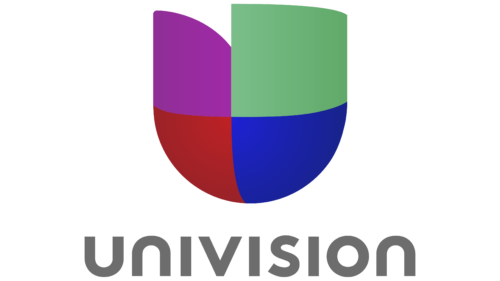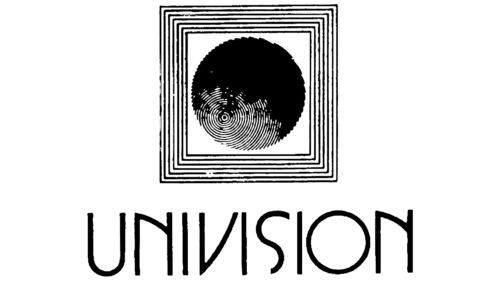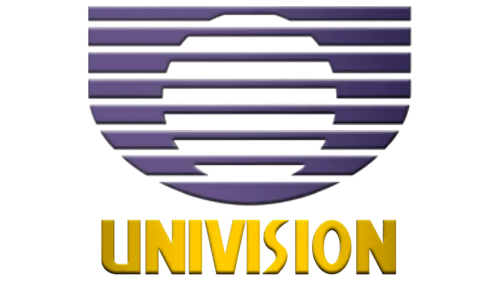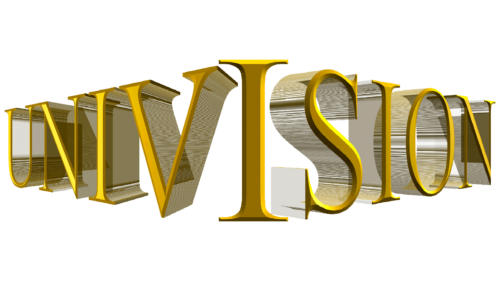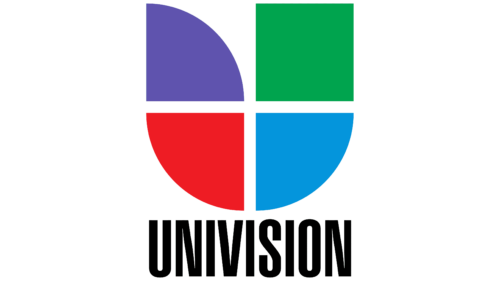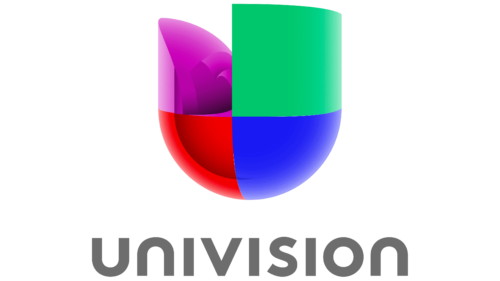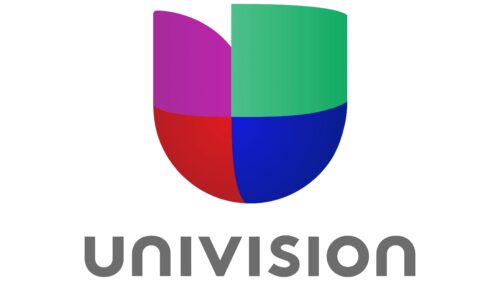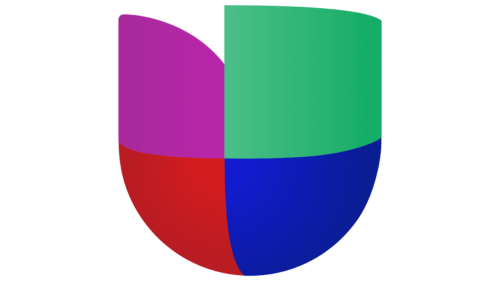The Univision logo is as vibrant and striking as all the network’s broadcasts. The emblem embodies the spirit of the passionate and emotional Latin American viewers who choose the company’s broadcasting. The symbol reflects the variety of content and the unification of disparate community groups.
Univision: Brand overview
| Founded: | September 29, 1962 |
| Founder: | TelevisaUnivision |
| Headquarters: | New York, NY, U.S. |
| Website: | univision.com |
Meaning and History
The precursor to Univision, station KCOR-TV, was launched in 1955. However, the active development of Spanish-language television in the U.S. started after the station was purchased by the owner of Spanish Televisa, Emilio Azcárraga, who subsequently opened other stations and established the Spanish international network SIN and the SICC corporation. The network subsequently underwent renaming, expansion, bankruptcy, and a new resurgence, but the Azcárraga family never let go of it.
As the company grew and expanded and as investor groups changed, the company’s visual identity evolved.
What is Univision?
One of the two largest television networks in America, targeting the country’s Spanish-speaking audience. It broadcasts American-produced shows and series purchased from Latin America. The audience is over 50 million people.
1962 – 1970
Initially, Azcárraga named his network simply: Spanish International Network, which was reflected in its logo. The name made it clear who the channels were broadcasting for and in which language. Using the name as an emblem was a smart move for the new network and for winning over U.S. Latinos.
1970 – 1987
Eight years later, the network was well-known, so its name was shortened to the acronym SIN. For the logo, they used a bold font that showed the scale of the corporation, which by that time, in addition to the two main ones, had opened about a dozen television companies throughout America with high ratings.
The letters S and N are cut into parts by paired stripes, showing the formation of a single corporation from whole parts. The solid central I seemed to connect the extreme symbols, in which, apparently, a message about spreading to the South and North was encrypted.
1986 – 1987
In 1987, one of the main owners of the American part of SIN, Azcárraga’s son-in-law Nicolas, sold his share to Hallmark Cards, which partnered with Televisa. The new owners renamed the group of studios Univision. Changes were likely planned even before the official announcement, as in 1986, Televisa filed for the trademarking of the name Univision in America.
The new company name is a combination of the words Uni and vision, translating as “unified vision.” The name conveyed the company’s goals – to unite Spanish-speaking residents, to represent their views, and to form a unified position among this category of U.S. citizens.
The image on the logo complemented the idea. At the center of the composition is the planet Earth, painted in black. In one part of it, a broadcasting point is depicted from which waves emanate, and light appears at the point of their propagation. The planet is enclosed in a frame of several such waves, showing the network’s goal to cover the entire Earth with its broadcast and promote the unity of the Spanish-speaking population. Moreover, the broadcasting waves emanated from the region of Latin America, which indicated the language and the audience the network was catering to.
1987
While the process of transition and renaming was going on, the Univision logo was changed, incorporating both the original and new names and an element taken from the Televisa logo, which effectively owned the American network all these years.
The three elements demonstrated the main aspects of the birth of Spanish-language broadcasting in America:
- The acquisition of the first channel by Televisa’s owner
- The creation of SIN by him
- The subsequent renaming to Univision
The emblem was meant to help users associate old and new names and remember them.
1987 – 1989
In the next transitional logo, the past name was removed, leaving only the Univision inscription and the image of the Earth submerged in broadcasting waves. The composition and elements of the emblem made the visual sign even more similar to Televisa’s identity, maintaining a hint at the network’s origin.
1989
The logo lasted for six months, from July to December. The image appeared to be forged out of gold, with waves reflecting on the side surfaces of the elements. The elegant letters formed a voluminous figure in the shape of angle sides, with the letter ‘I’ prominently placed in the center.
The composition showed that the individual’s identity is at the heart of the company’s activities. In choosing programs, it focuses on the preferences of its users and strives to facilitate the self-determination and self-expression of Spanish-speaking residents of America.
The placement broke the name into three parts: Univ i sion, with the encrypted words “University of Zion.” Zion is a mountain in Israel associated with a believing community and salvation. And most Latin Americans are devout Catholics.
1990 – 2012
Univision came under the ownership of Hallmark. As a result, Televisa terminated its contract with the network and took back its programs. The disappearance of familiar and beloved shows caused a loss of viewers and subsequent bankruptcy in 1990. Having crashed, Hallmark sold the network to a group of investors, giving it a new life. Among the new owners was a company from the Televisa group once again.
The logo of the turn of the 21st century was designed by New York graphic designers from the firm Chermayeff & Geismar. The experts suggested a different approach to visual identity, making a multicolored figure the center of the composition, incorporating elements of green, blue, red, and purple. The blocks formed the capital letter U – the first in the name Univision.
Specifically, red, green, and blue are the basis of the color image of the TV – the RGB color model. Therefore, the composition clearly shows the company’s affiliation with broadcasting.
The figure is created on the principle of the Windows visual sign and hints at the “window to the world” that the network provides to its viewers.
2012 – 2019
In 2011, Televisa once again bought a stake in the network, which it had left in 2005 due to a conflict with the main owner. Thanks to the collaboration, Univision became multi-platform and grew significantly. This required a review of the visual identity.
The new logo was designed by the British design agency Wolff Olins. The artists managed to create the most vibrant and impressive logo for the network, making the elements voluminous with a glossy, streamlined mirror surface.
The figure gained the sense of a technogenic 3-D wonder from the future. This demonstrated the network’s foresight, technological development, and the provision of the most modern services to its users. It hinted at the management’s desire for modernization and the transition to innovations and unique developments in the field of broadcasting.
All elements of the figure merged into one, becoming the prototype of a heart. The symbol shows Univision’s love, which the company gives to its viewers. It also indicates the reciprocated loyalty of customers actively choosing this particular network. The studio became a hub for the most beloved shows.
The absence of seams between the elements shows the unity of Spanish-speaking people on different continents.
2019 – today
The flamboyant Sibling Rivalry Studio worked on the latest interpretation of the emblem. They simplified the bright futuristic style. The image retained its overall appearance, composition, and volume. However, the elements lost their shine and reflectiveness, making the emblem more trivial. The size of the green part also decreased, adding compactness.
Font and Colors
The color palette of the Univision logo is bright and saturated. It includes the primary colors of the RGB model, which eventually form all existing shades on the screen. Each color reflects the direction of the studio’s content.
- Red – top-rated shows, passionate Latin American audience.
- Green – content that helps all Spanish-speaking groups grow and unite into a whole.
- Blue – development and intellectual growth, thanks to the network’s educational shows.
- Purple – unleashing potential, exploring the unknown, self-improvement, art, music.
The font of the inscription is smooth and streamlined – Posterama 1984 Bold. It demonstrates the studio’s ability to smooth over disagreements between immigrants and native Latin Americans in the US, taking into account the interests of all groups.
Univision color codes
| Vivid Violet | Hex color: | #952d9c |
|---|---|---|
| RGB: | 149 45 156 | |
| CMYK: | 4 71 0 39 | |
| Pantone: | PMS 254 C |
| Fern | Hex color: | #69b174 |
|---|---|---|
| RGB: | 105 177 116 | |
| CMYK: | 41 0 34 31 | |
| Pantone: | PMS 7479 C |
| Fire Brick | Hex color: | #ae2226 |
|---|---|---|
| RGB: | 174 34 38 | |
| CMYK: | 0 80 78 32 | |
| Pantone: | PMS 1795 C |
| Zaffre | Hex color: | #1a22aa |
|---|---|---|
| RGB: | 26 34 170 | |
| CMYK: | 85 80 0 33 | |
| Pantone: | PMS Blue 072 C |
| Dim Gray | Hex color: | #6d6d6d |
|---|---|---|
| RGB: | 109 109 109 | |
| CMYK: | 0 0 0 57 | |
| Pantone: | PMS 424 C |
